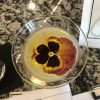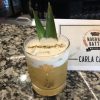
Over the past few years, we’ve seen lots of new bourbons hit the shelves. Right alongside them has been a growing collection of bottles filled with a clear spirit. Variously labeled white whiskey, unaged whiskey or the colloquial white dog, this is “pre-bourbon,” the spirit before it has picked up that nice amber color and those wonderful caramel and vanilla flavors from aging for years in a charred oak barrel.
This is partly a reflection of the current craze for anything related to bourbon. On one end of the spectrum you have the pricey super-premium and overaged bourbons; on the other end, you have this homage to the moonshine history, which was as colorful as its products weren’t. But unaged whiskeys are also a way for distillers, particularly small craft distillers, to bring in some cash until their bourbons are ready, a process that usually takes four to six years or more – a long time to wait for a return on investment.
Now a really huge distiller, Jim Beam, has gotten into the white whiskey business with Jacob’s Ghost, named for its founding father. Beam notes in press materials that Jacob’s Ghost is not moonshine, nor is it unaged. It is aged for at least one year in a charred barrel, which it says gives the whiskey “a smooth, sweet flavor with hints of smoke, rounded out by soft barrel notes on the finish.”
While Slate.com’s Drink writer Reid Mitenbuler didn’t give a specific reaction to Jacob’s Ghost in a story posted last Friday, you can get the gist from the headline: “Putting the White Dog To Sleep: Unaged whiskey helps young microdistilleries keep afloat. There’s just one problem: It tastes awful.”
Without the final step of aging in barrels, Reid writes, “white dog is to whiskey what coal is to diamonds.” The story’s suggestion: Rather than drum up early capital with white dog, microdistillers should consider making gin instead. “Like white dog, gin is distilled from grains, but it passes through botanicals like juniper berries, coriander, and cardamom to absorb appealing flavors,” Reid writes – and it requires no aging.
However, it’s also apparently very difficult to scrub out of the still. Drew Mayville, director of quality at Buffalo Trace, told me on a recent visit that he would love to make a distilled gin on the distillery’s mini-still, but master distiller Harlen Wheatley “would kill me. He doesn’t want to run gin anywhere in the distillery. Gin will stick around in all these columns. It’s dangerous thing. I’ve heard stories – you could be making the next product and you’re going to taste gin in it. Gin sticks around forever.”
Meanwhile, Beam kindly provided the Bourbon Babe with a bottle of Jacob’s Ghost, and I’ll share my tasting notes tomorrow.





